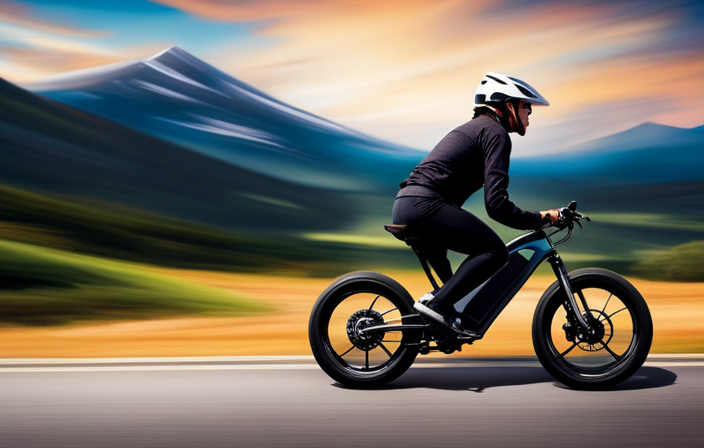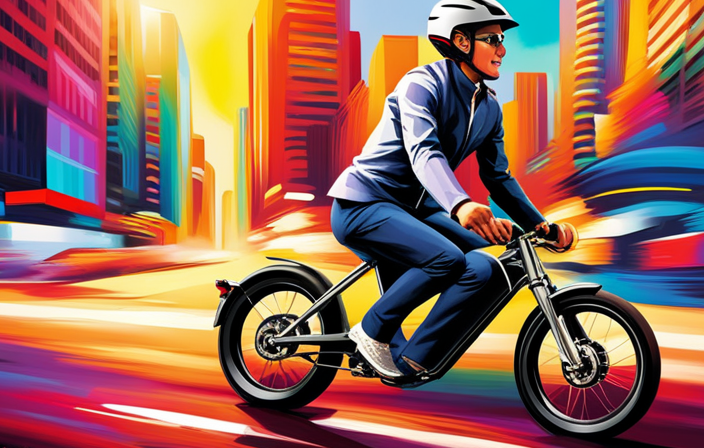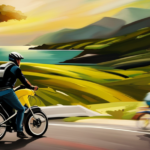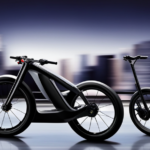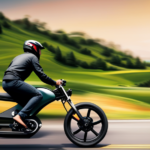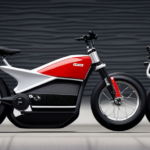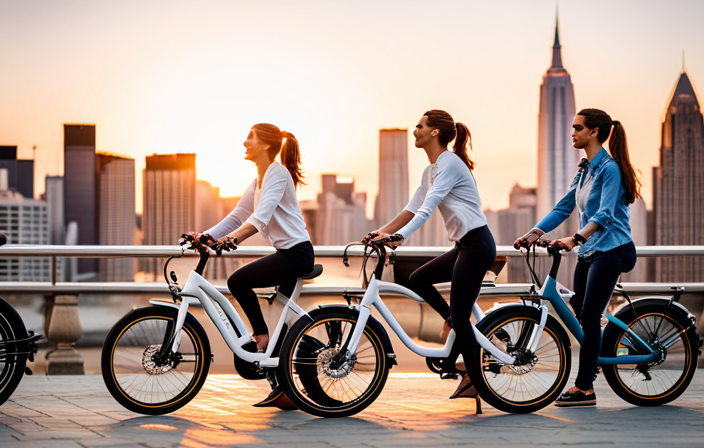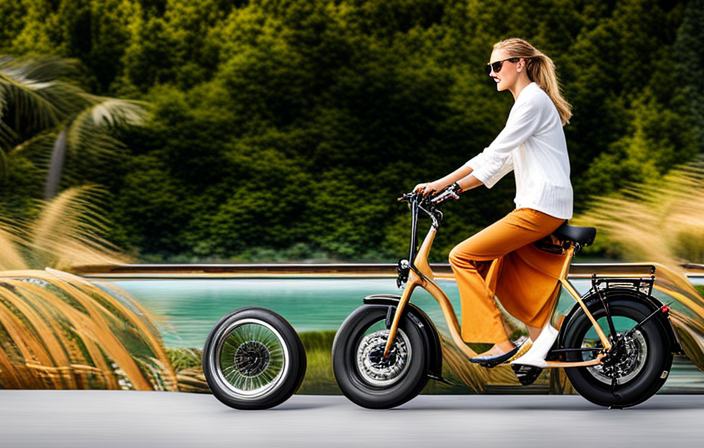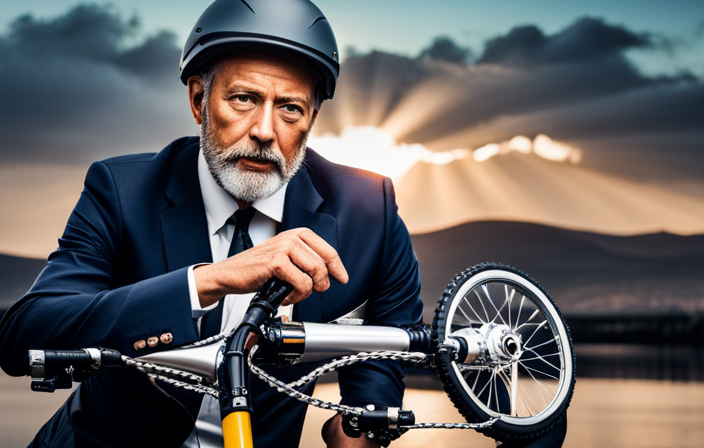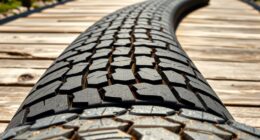Envision sailing smoothly through the city, with the breeze playing through your hair, as you achieve thrilling velocities. Electric bicycles have transformed our mode of transportation, presenting an exciting mix of potency and efficiency.
But just how fast can these eco-friendly machines go? In this article, we will delve into the world of electric bikes, exploring the factors that influence their speed, legal limits, myths surrounding their capabilities, and future developments that promise even greater velocity.
So buckle up, and let’s embark on a journey to discover the speed limits of electric bikes.
Key Takeaways
- Electric bikes have a battery-powered motor that assists the rider while pedaling, allowing them to go faster than traditional bikes.
- The speed of an electric bike is determined by the motor power and wattage, as well as factors such as rider weight, cargo, terrain, and wind resistance.
- Different countries have different speed limits for electric bikes, and it is important to be aware of these limits to ride safely and legally.
- The average speed range of an electric bike depends on factors such as terrain and battery capacity, with speeds ranging from 15-30 mph.
Understanding Electric Bikes
Electric bikes, or e-bikes, are becoming increasingly popular due to their ability to reach high speeds while providing a more environmentally friendly mode of transportation. These bikes are equipped with a battery-powered motor that assists the rider while pedaling, allowing them to travel faster and with less effort.
One of the main benefits of electric bikes is their use for commuting. With their ability to maintain higher speeds, e-bikes can help commuters reach their destinations more quickly, while also reducing the reliance on cars or public transportation.
Additionally, e-bikes offer recreational advantages, allowing riders to explore new areas or enjoy outdoor activities without getting exhausted.
Understanding how electric bikes work is crucial to fully appreciate their benefits and capabilities. So, let’s dive into the next section and explore the mechanics behind these innovative modes of transportation.
How Do Electric Bikes Work?
Powered by a battery, e-bikes utilize advanced technology to effortlessly propel riders forward. Understanding motor power, battery capacity, and range is key to comprehending how electric bikes work. Here are five important aspects to consider:
-
Motor Power: The power of an electric bike’s motor determines how fast it can go. Higher wattage motors provide more power and faster speeds.
-
Battery Capacity: The capacity of the battery affects the distance an electric bike can travel. Larger capacity batteries allow for longer rides before recharging.
-
Range: The range of an electric bike refers to the distance it can travel on a single charge. It depends on factors like terrain, rider weight, and speed.
These factors play a crucial role in determining the speed of an electric bike. By understanding motor power, battery capacity, and range, riders can make informed decisions about their electric bike’s performance.
Transitioning into the next section, let’s delve into the various factors that influence electric bike speed without delay.
Factors Affecting Electric Bike Speed
Boost your e-bike’s speed by understanding the various factors that influence how quickly you can zip through the streets.
When it comes to electric bike speed, there are several key factors to consider. First and foremost, the power and wattage of the motor play a significant role in determining how fast your electric bike can go. Additionally, the weight of the rider and any cargo being carried can impact speed.
Another important factor is the terrain you are riding on. Uphill climbs will naturally slow down your electric bike, while flat or downhill surfaces will allow for faster speeds. It’s also worth mentioning that wind resistance can affect the overall speed of your e-bike.
By considering these electric bike speed factors, you can optimize your ride for a faster and more efficient experience.
Now, let’s dive into the topic of legal speed limits for electric bikes.
Legal Speed Limits for Electric Bikes
When it comes to electric bikes, it’s important to understand the legal speed limits that apply to them.
One key point to consider is the regulations and classifications that determine how fast an electric bike can go. Different countries have different speed limits for electric bikes, so it’s crucial to be aware of the specific rules and restrictions in your location.
Being knowledgeable about these speed limits will ensure that you ride your electric bike safely and in compliance with the law.
Regulations and Classifications
Electric bikes have different classifications and regulations that determine how fast they can go. These regulations vary by country and often depend on the maximum speed and power of the electric bike. In the United States, for example, there are three classes of electric bikes: Class 1, Class 2, and Class 3. Each class has a different maximum speed limit. Class 1 electric bikes have a maximum assisted speed of 20 mph, Class 2 electric bikes have a maximum assisted speed of 20 mph as well, but can also be propelled without pedaling, and Class 3 electric bikes have a maximum assisted speed of 28 mph. These regulations ensure that electric bikes can be used safely and responsibly on public roads. Now, let’s explore the different speed limits by country.
Different Speed Limits by Country
You might be wondering, how do different countries determine the speed limits for electric bikes?
Well, it turns out that speed limits for electric bikes vary from country to country due to a variety of factors, including cultural differences and safety concerns.
For example, in the United States, electric bikes are typically limited to a top speed of 20 mph (32 km/h) when operated using the motor alone.
In some European countries, such as Germany and the Netherlands, the speed limit is slightly higher at 25 km/h (15.5 mph).
On the other hand, countries like Canada and Australia have higher speed limits of up to 32 km/h (20 mph).
These variations in speed limits reflect the different priorities and regulations set by each country.
Moving on to the next section about the average speed range of electric bikes…
Average Speed Range of Electric Bikes
To get the most out of your electric bike, it’s important to know that their average speed range can vary depending on factors such as terrain and battery capacity. Electric bikes are designed to assist riders, allowing them to reach higher speeds than traditional bicycles. However, it’s important to note that there are legal speed limits in place in different countries, especially for speed pedelecs, which are electric bikes that can reach higher speeds.
Here is a table showcasing the average speed range of electric bikes:
| Terrain | Battery Capacity | Average Speed Range |
|---|---|---|
| Flat | Low | 15-20 mph |
| Hilly | Medium | 20-25 mph |
| Mountainous | High | 25-30 mph |
Knowing the average speed range of your electric bike can help you plan your rides accordingly and ensure that you have enough battery capacity to reach your destination. Commuting with an electric bike offers a convenient and eco-friendly alternative to traditional transportation methods.
Commuting with an Electric Bike
Imagine effortlessly cruising through traffic and arriving at your destination in no time, all while reducing your carbon footprint – that’s the beauty of commuting with an electric bike.
Electric bikes offer numerous benefits for daily commutes. Firstly, they are cost-effective, requiring only a fraction of the cost of owning a car or using public transportation. With rising fuel prices, an electric bike provides a budget-friendly alternative.
Additionally, electric bikes allow you to skip the traffic jams and easily navigate through crowded streets, saving you time and frustration. They also promote a healthier lifestyle by providing the option to pedal or use the electric motor, allowing you to customize your level of physical exertion.
So, if you’re looking for an efficient and eco-friendly way to commute, an electric bike is the perfect choice.
Now, let’s explore how electric bikes can enhance your recreational and adventurous experiences.
Electric Bikes for Recreation and Adventure
When it comes to electric bikes for recreation and adventure, there are two key points that stand out: off-road capabilities and mountain biking speeds.
Off-road capabilities are a crucial factor to consider for those looking to explore rugged terrains and conquer challenging trails. Electric bikes with excellent off-road capabilities can handle uneven surfaces, steep inclines, and rough trails with ease.
Additionally, the speeds that electric mountain bikes can reach are impressive, allowing riders to experience the thrill of downhill descents and the exhilaration of high-speed trail riding.
Whether you’re a seasoned mountain biker or a beginner looking to venture into off-road adventures, electric bikes offer a thrilling and capable mode of transportation.
Off-Road Capabilities
Get ready to experience the exhilarating off-road capabilities of an electric bike and feel the speed like never before! When it comes to tackling off-road terrain, electric bikes are equipped with features that ensure a smooth and thrilling ride.
One important feature is the suspension system, which helps absorb the impact of bumps and uneven surfaces, providing a comfortable and stable ride. With the right suspension setup, you can confidently conquer rocky trails, muddy paths, and even steep inclines.
Electric bikes also offer excellent traction, thanks to their wide and grippy tires, allowing you to maintain control even on challenging surfaces. Additionally, the powerful electric motor provides instant acceleration, making it easier to navigate through rough terrains.
So get ready to push the limits of what’s possible on an electric bike and experience the thrill of off-road adventures!
Speaking of speed, let’s dive into the next topic of mountain biking speeds.
Mountain Biking Speeds
Zooming down the trail, riders on mountain bikes can feel the rush of adrenaline as they push the limits of speed and skill. Mountain biking requires a combination of techniques and proper gear selection to ensure a safe and exhilarating ride.
When it comes to speed, mountain bikers aim to find the perfect balance between momentum and control. By utilizing efficient pedaling techniques and maintaining a low center of gravity, riders can maximize their speed without compromising stability.
Choosing the right gear is crucial in achieving optimal speeds on the trails. With a wide range of gear ratios to choose from, riders can customize their bike’s performance to match the terrain. From steep climbs to fast descents, having the right gear allows riders to maintain momentum and conquer any challenge.
Transitioning into the next section, high-performance electric bikes offer even greater speed and power for those seeking an extra boost on the trails.
High-Performance Electric Bikes
When it comes to high-performance electric bikes, two key points to consider are Speed Pedelecs and S-Pedelecs, as well as racing and speed records.
Speed Pedelecs are electric bikes that can reach speeds of up to 28 mph, providing a thrilling experience for riders who crave extra speed.
S-Pedelecs, on the other hand, can reach even higher speeds of up to 45 mph, making them the ultimate choice for adrenaline junkies.
Additionally, the world of electric bike racing has seen numerous speed records shattered, with riders pushing the boundaries of what is possible on these powerful machines.
Speed Pedelecs and S-Pedelecs
Imagine cruising down the road on a speed pedelec or S-pedelec, feeling the exhilarating rush as you effortlessly reach top speeds. These high-performance electric bikes are designed to offer a thrilling experience while adhering to certain speed restrictions.
Here are some key points to know about speed pedelecs and S-pedelecs:
- Speed restrictions: These bikes are capable of reaching speeds up to 28 mph (45 km/h), allowing you to cover longer distances in less time.
- Performance capabilities: Equipped with powerful motors and advanced battery systems, speed pedelecs and S-pedelecs offer excellent acceleration and can easily handle steep inclines.
- Safety features: To ensure rider safety, these bikes often come with enhanced braking systems, suspension forks, and wider tires for better stability and control.
- Legal requirements: In some countries, riding these bikes may require a license, registration, or insurance due to their higher speeds.
Now, let’s delve into the exciting world of racing and speed records, where these electric bikes truly shine.
Racing and Speed Records
Get ready to experience the thrill of racing on a speed pedelec or S-pedelec. Push the boundaries of speed and chase after exhilarating new records.
To excel in electric bike racing, it is crucial to master various racing techniques and implement effective speed training methods. One key technique is learning how to optimally utilize the motor assistance to maximize acceleration and maintain high speeds.
Understanding the dynamics of bike handling and cornering can give you an edge over your competitors. Additionally, interval training sessions can improve your cardiovascular fitness, while hill repeats can enhance your leg strength and power.
By combining these techniques and training methods, you can improve your racing performance and reach new levels of speed on your electric bike.
Now, let’s explore the factors to consider for choosing an electric bike.
Factors to Consider for Choosing an Electric Bike
When choosing an electric bike, it’s important to consider a few key factors.
First, think about your desired speed versus range. If you need to travel long distances, you may prioritize a bike with a longer range over one that offers high speeds.
Secondly, consider the purpose and intended use of the bike. Are you planning on using it for commuting, off-roading, or leisurely rides? This will help determine the type of bike that best suits your needs.
Lastly, take into account any specific features or functionalities that are important to you, such as suspension, battery capacity, or motor power.
By considering these factors, you can make an informed decision and find the perfect electric bike for your lifestyle.
Speed vs. Range
To optimize your electric bike experience, consider the trade-off between speed and range.
When it comes to electric bikes, speed is directly related to power. The more powerful the motor, the faster the bike can go. However, it’s important to note that speed can be affected by various factors, such as the weight of the rider and the terrain. Uphill climbs and rough terrains can significantly impact the speed of an electric bike.
It’s also worth mentioning that higher speeds usually result in reduced range, as the motor consumes more energy. Therefore, if you prioritize speed, you may have to compromise on the distance you can travel on a single charge.
Understanding the relationship between speed and range will help you make an informed decision based on your purpose and intended use of the electric bike.
Purpose and Intended Use
When considering the speed of an electric bike, it is important to take into account its purpose and intended use. Electric bikes can be used for both commuting and leisure purposes, and the desired speed may vary depending on these factors.
For commuting, a higher speed may be preferred in order to reach the destination quickly and efficiently. On the other hand, for leisurely rides, a slower speed may be more enjoyable, allowing for a relaxed and comfortable experience.
It is also important to consider the relationship between speed and power. Higher speeds often require more power, which can impact the range of the electric bike. Therefore, it is crucial to find a balance between speed and power that suits your specific needs.
Moving on to safety considerations for riding at higher speeds…
Safety Considerations for Riding at Higher Speeds
When riding an electric bike at higher speeds, it’s important to prioritize safety.
Wearing a helmet and appropriate protective gear is crucial to protect yourself in case of a fall or accident.
Additionally, understanding the braking system and how to handle the bike at higher speeds is essential for maintaining control and avoiding potential dangers.
By taking these safety considerations into account, you can confidently enjoy the thrill of riding at higher speeds on your electric bike.
Helmet and Protective Gear
Wearing a helmet and protective gear is crucial for your safety while riding an electric bike. Helmet safety is of utmost importance when it comes to protecting your head in case of an accident. A good quality helmet should fit snugly and have proper ventilation to keep you comfortable. It should also meet safety standards and have a secure strap to keep it in place.
In addition to a helmet, wearing other protective gear such as knee pads, elbow pads, and gloves can provide further protection in case of a fall or collision. These gear help protect your vulnerable joints and prevent injuries.
Moving on to the next topic of braking and handling, it is essential to have a good understanding of how to safely control your electric bike at higher speeds.
Braking and Handling
Mastering the art of smoothly stopping and maneuvering an electric bike is a skill that can make all the difference in your riding experience. When it comes to braking techniques, it’s important to remember that electric bikes have different braking systems compared to traditional bicycles.
Most electric bikes have both front and rear disc brakes, which provide reliable stopping power. To ensure effective braking, evenly distribute your weight on both pedals while applying the brakes gradually.
Additionally, when maneuvering your electric bike, keep in mind that they can be slightly heavier than regular bikes due to the motor and battery. To enhance maneuverability, practice leaning into turns, shifting your body weight, and using the handlebars to guide your bike.
By mastering these braking techniques and maneuverability tips, you’ll have a smoother and safer ride.
Now, let’s move on to maintenance tips for optimal performance.
Maintenance Tips for Optimal Performance
When it comes to maintaining optimal performance for your electric bike, there are two key areas to focus on: regular battery charging and care, and motor and drive system maintenance.
It is crucial to keep your battery charged regularly to ensure consistent power and performance.
Additionally, proper care and maintenance of the motor and drive system will help extend the lifespan of your electric bike and ensure smooth and efficient operation.
By following these maintenance tips, you can enjoy the full benefits of your electric bike for years to come.
Regular Battery Charging and Care
Regular maintenance and proper charging of the battery are crucial for maximizing the speed and performance of an electric bike. To ensure a long battery lifespan, it is essential to follow these guidelines:
- Charge the battery after every ride, regardless of the distance traveled.
- Use the recommended charger provided by the manufacturer to avoid any compatibility issues.
- Avoid overcharging the battery, as it can negatively impact its longevity.
- Store the battery in a cool and dry place, away from direct sunlight or extreme temperatures.
- Regularly inspect the battery for any signs of damage or wear.
By following these steps, you can ensure that your electric bike’s battery remains in optimal condition, providing you with a reliable power source for your rides.
Moving on to motor and drive system maintenance, it is equally important to keep these components in top shape for a smooth and efficient riding experience.
Motor and Drive System Maintenance
To keep your motor and drive system running smoothly, you’ll want to keep up with regular maintenance and make sure they’re in top shape. Here are a few maintenance tips to help you maintain optimal performance.
First, regularly check the motor for any signs of wear or damage. Inspect the drive system, including the chain and sprockets, for any signs of wear or misalignment.
It’s also important to keep the motor and drive system clean and free from dirt and debris. Regularly lubricate the chain to ensure smooth operation.
Additionally, consider performance enhancements such as upgrading to a more powerful motor or installing a larger battery pack for increased speed and range.
By following these maintenance tips and considering performance enhancements, you can improve your electric bike’s speed and performance.
Improving Electric Bike Speed
When it comes to improving the speed of an electric bike, there are two key points to consider: upgrading components and enhancing aerodynamics.
Upgrading components such as the motor, battery, and controller can significantly increase the bike’s power and speed.
Additionally, making changes to enhance the bike’s aerodynamics, such as adding fairings or adjusting the riding position, can reduce wind resistance and improve overall speed.
By focusing on these two areas, riders can achieve a faster and more efficient electric bike experience.
Upgrading Components
With a few component upgrades, your electric bike can transform into a sleek, high-performance machine that zooms like lightning. Here are three key upgrades that can enhance performance and optimize efficiency:
-
Swap out the stock battery for a higher-capacity lithium-ion battery. This will provide more power and increase your bike’s range, allowing you to go faster and farther.
-
Upgrade the motor to a higher wattage. A more powerful motor will deliver increased torque and acceleration, giving you the extra boost you need to reach higher speeds quickly.
-
Install a lightweight carbon fiber frame. Not only will this reduce the overall weight of your bike, but it will also improve its handling and responsiveness, making it more agile and nimble on the road.
By enhancing these components, you can significantly improve your electric bike’s speed and performance.
Now, let’s delve into enhancing aerodynamics to further maximize your ride.
Enhancing Aerodynamics
Enhancing the aerodynamics of your electric bike can make you feel like you’re gliding through the air effortlessly. By making aero modifications to your bike, you can reduce wind resistance and increase your speed.
One way to enhance aerodynamics is by installing a fairing, which is a streamlined cover that reduces turbulence caused by the rider and the bike’s components.
Another option is to add aerodynamic handlebars that allow you to maintain a more streamlined position.
Additionally, upgrading to aero wheels can further reduce drag and increase your overall speed.
These modifications may seem small, but they can make a significant difference in your biking experience. With reduced wind resistance, you’ll be able to achieve higher speeds and cover more ground effortlessly.
Now, let’s debunk some common electric bike speed myths.
Electric Bike Speed Myths
I’m here to debunk some common misconceptions about electric bike speed and separate fact from fiction.
There are many myths swirling around about how fast electric bikes can go, and it’s important to know the truth.
In this discussion, I’ll provide you with detailed information to clarify these misconceptions and give you a clear understanding of electric bike speeds.
Debunking Common Misconceptions
Imagine yourself cruising down the street on an electric bike, debunking common misconceptions about its speed. Electric bikes have often been associated with slow speeds, but this is far from the truth. Let’s separate fact from fiction and explore the reality behind these electric bike speed myths.
| Myths | Debunked |
|---|---|
| Electric bikes are sluggish | Electric bikes can reach speeds of up to 28 mph, depending on the model and local regulations. |
| Electric bikes are only for leisurely rides | Electric bikes are versatile and can be used for commuting, running errands, and even tackling uphill terrains. |
| Electric bikes are not as fast as regular bikes | While electric bikes assist your pedaling, they can still reach impressive speeds comparable to traditional bikes. |
It’s important to remember that electric bike speed depends on various factors such as the motor power, battery capacity, and rider input. So next time you hop on an electric bike, rest assured that you can experience thrilling rides while effortlessly separating fact from fiction about their speed.
Separating Fact from Fiction
Get ready to embark on a journey of truth and clarity as we delve into the realm of electric bike speed, separating fact from fiction and shedding light on the reality behind the misconceptions.
When it comes to electric bike safety, speed optimization plays a crucial role. Many people falsely believe that electric bikes are inherently dangerous due to their speed, but this is not the case. In fact, electric bikes are designed with safety in mind, and their top speeds are limited to ensure rider stability and control.
Additionally, riders can choose to adjust the speed settings on their electric bikes to suit their comfort level and riding conditions. By debunking the misconception that electric bikes are dangerously fast, we can encourage more people to embrace this eco-friendly mode of transportation.
Looking ahead, future developments in electric bike speed will focus on further enhancing safety features while maximizing efficiency and performance.
Future Developments in Electric Bike Speed
In the future, advancements in battery technology will play a crucial role in improving the speed of electric bikes. With the development of more efficient and powerful batteries, electric bikes will be able to reach higher speeds and cover longer distances.
Additionally, performance improvements in motor technology and overall bike design will also contribute to faster electric bike speeds.
Advancements in Battery Technology
With advancements in battery technology, you can now zip around on an electric bike at speeds you never thought possible. This is made possible by the following developments:
-
Advancements in charging technology: Faster charging times mean less downtime and more time spent riding. Imagine being able to fully charge your electric bike in just a few hours instead of waiting overnight.
-
Impact of battery capacity: Higher battery capacity allows for longer rides without worrying about running out of power. You can now go on extended adventures without the need to constantly recharge.
-
Improved energy density: Batteries with higher energy density are smaller and lighter, making electric bikes more agile and easier to maneuver. You can navigate through traffic effortlessly and enjoy a more dynamic riding experience.
-
Enhanced power output: Modern batteries can deliver a higher power output, enabling electric bikes to reach higher speeds and tackle steeper hills with ease.
With these advancements in battery technology, electric bikes are not only becoming faster, but also more efficient and reliable.
Transitioning into the subsequent section about performance improvements, it’s important to consider how these advancements are also contributing to a more enjoyable riding experience.
Performance Improvements
One fascinating statistic to consider is that the average speed of electric bikes has increased by 20% over the past five years, thanks to performance improvements. These advancements have focused on improving acceleration and optimizing power output, resulting in a more efficient and faster riding experience.
With better battery technology and motor systems, electric bikes can now provide a higher level of power and torque, allowing riders to reach higher speeds more quickly. The acceleration has significantly improved, making it easier to navigate through traffic and climb steep hills. Additionally, manufacturers have fine-tuned the power output to ensure a smoother and more controlled ride.
These performance improvements have not only enhanced the overall speed of electric bikes but also increased their efficiency. Finding the perfect balance of speed and efficiency is crucial to ensure an enjoyable and practical riding experience.
Conclusion: Finding the Perfect Balance of Speed and Efficiency
To find the perfect balance of speed and efficiency, you gotta know just how fast an electric bike can go. When it comes to electric bikes, speed is determined by various factors such as the power of the motor and the gear ratio. By finding the right gear ratio and maximizing motor power, you can achieve impressive speeds on your electric bike. However, it’s important to strike a balance between speed and efficiency. Going too fast can drain the battery quickly and decrease your overall range. To help you visualize this balance, here is a 3 column and 5 row table:
| Speed (mph) | Efficiency (%) | Battery Range (miles) |
|---|---|---|
| 15 | 90 | 30 |
| 20 | 80 | 25 |
| 25 | 70 | 20 |
| 30 | 60 | 15 |
| 35 | 50 | 10 |
As you can see, as speed increases, efficiency and battery range decrease. So, it’s important to find the sweet spot that suits your needs and preferences.
Frequently Asked Questions
Are electric bikes allowed on all roads and bike lanes?
Electric bikes are subject to regulations that vary by jurisdiction. While they are generally allowed on roads and bike lanes, it is important to consult local laws to ensure compliance and address safety concerns.
Can I ride an electric bike in the rain?
Yes, you can ride an electric bike in the rain. However, it’s important to take proper precautions and perform regular maintenance. To ride in wet conditions, ensure your bike has fenders, use a waterproof cover for the battery, and dry off the bike after riding.
How long does it take to charge an electric bike battery?
On average, it takes around 3-6 hours to fully charge an electric bike battery, depending on its capacity. This allows for a longer ride time and ensures you won’t run out of power mid-journey.
Do electric bikes require a driver’s license?
Yes, electric bikes do not require a driver’s license in most places. However, it’s important to check local regulations as they may have specific speed limits for electric bikes.
Can I ride an electric bike without pedaling?
Yes, you can ride an electric bike without pedaling. By using the throttle, you can effortlessly cruise along. Although some may argue it’s not as physically demanding, it still offers health benefits compared to traditional bikes.
Conclusion
In conclusion, finding the perfect balance of speed and efficiency is essential when it comes to electric bikes. By understanding how they work and the factors that affect their speed, riders can make informed choices.
While legal speed limits exist, the average speed range of electric bikes is impressive. And for those looking to improve their speed, there are ways to do so.
So, let’s debunk the myths and embrace the future developments in electric bike speed. Get ready to zip through the streets with style and grace!
